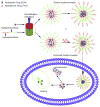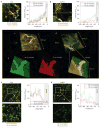Recent Developments in Active Tumor Targeted Multifunctional Nanoparticles for Combination Chemotherapy in Cancer Treatment and Imaging
- PMID: 26554150
- PMCID: PMC4816444
- DOI: 10.1166/jbn.2015.2145
Recent Developments in Active Tumor Targeted Multifunctional Nanoparticles for Combination Chemotherapy in Cancer Treatment and Imaging
Abstract
Nanotechnology and combination therapy are two major fields that show great promise in the treatment of cancer. The delivery of drugs via nanoparticles helps to improve drug's therapeutic effectiveness while reducing adverse side effects associated wifh high dosage by improving their pharmacokinetics. Taking advantage of molecular markers over-expressing on tumor tissues compared to normal cells, an "active" molecular marker targeted approach would be-beneficial for cancer therapy. These actively targeted nanoparticles would increase drug concentration at the tumor site, improving efficacy while further reducing chemo-resistance. The multidisciplinary approach may help to improve the overall efficacy in cancer therapy. This review article summarizes recent developments of targeted multifunctional nanoparticles in the delivery, of various drugs for a combinational chemotherapy approach to cancer treatment and imaging.
Figures

















Similar articles
-
Recent progress in nanotechnology for cancer therapy.Chin J Cancer. 2010 Sep;29(9):775-80. doi: 10.5732/cjc.010.10075. Chin J Cancer. 2010. PMID: 20800018 Review.
-
A targeted nanoplatform co-delivering chemotherapeutic and antiangiogenic drugs as a tool to reverse multidrug resistance in breast cancer.Acta Biomater. 2018 Jul 15;75:398-412. doi: 10.1016/j.actbio.2018.05.050. Epub 2018 Jun 3. Acta Biomater. 2018. PMID: 29874597
-
Advanced targeted therapies in cancer: Drug nanocarriers, the future of chemotherapy.Eur J Pharm Biopharm. 2015 Jun;93:52-79. doi: 10.1016/j.ejpb.2015.03.018. Epub 2015 Mar 23. Eur J Pharm Biopharm. 2015. PMID: 25813885 Review.
-
Role of integrated cancer nanomedicine in overcoming drug resistance.Adv Drug Deliv Rev. 2013 Nov;65(13-14):1784-802. doi: 10.1016/j.addr.2013.07.012. Epub 2013 Jul 21. Adv Drug Deliv Rev. 2013. PMID: 23880506 Review.
-
Multifunctional magneto-polymeric nanohybrids for targeted detection and synergistic therapeutic effects on breast cancer.Angew Chem Int Ed Engl. 2007;46(46):8836-9. doi: 10.1002/anie.200703554. Angew Chem Int Ed Engl. 2007. PMID: 17943947 No abstract available.
Cited by
-
Investigation of Dextran-Coated Superparamagnetic Nanoparticles for Targeted Vinblastine Controlled Release, Delivery, Apoptosis Induction, and Gene Expression in Pancreatic Cancer Cells.Molecules. 2020 Oct 15;25(20):4721. doi: 10.3390/molecules25204721. Molecules. 2020. PMID: 33076247 Free PMC article.
-
Fe3O4 Nanoparticles That Modulate the Polarisation of Tumor-Associated Macrophages Synergize with Photothermal Therapy and Immunotherapy (PD-1/PD-L1 Inhibitors) to Enhance Anti-Tumor Therapy.Int J Nanomedicine. 2024 Jul 17;19:7185-7200. doi: 10.2147/IJN.S459400. eCollection 2024. Int J Nanomedicine. 2024. PMID: 39050876 Free PMC article.
-
Potential Therapeutic Targets of Resveratrol, a Plant Polyphenol, and Its Role in the Therapy of Various Types of Cancer.Molecules. 2022 Apr 21;27(9):2665. doi: 10.3390/molecules27092665. Molecules. 2022. PMID: 35566016 Free PMC article. Review.
-
Cancer-Associated PIK3R1 Genetic Aberrations and Precision Medicine.Int J Med Sci. 2025 Jun 12;22(12):2932-2943. doi: 10.7150/ijms.109506. eCollection 2025. Int J Med Sci. 2025. PMID: 40657399 Free PMC article. Review.
-
Updated aspects of alpha-Solanine as a potential anticancer agent: Mechanistic insights and future directions.Food Sci Nutr. 2024 Aug 29;12(10):7088-7107. doi: 10.1002/fsn3.4221. eCollection 2024 Oct. Food Sci Nutr. 2024. PMID: 39479710 Free PMC article. Review.
References
-
- Bangham A, Horne R. Negative staining of phospholipids and their structural modification by surface-active agents as observed in the electron microscope. J Mol Biol. 1964;8:660. - PubMed
-
- Zhang L, Radovic-Moreno AF, Alexis F, Gu FX, Basto PA, Bagalkot V, Jon S, Langer RS, Farokhzad OC. Co-delivery of hydrophobic and hydrophilic drugs from nanoparticle-aptamer bioconjugates. Chem Med Chem. 2007;2:1268. - PubMed
-
- Davis M, Chen Z, Shin D. Nanoparticle therapeutics: An emerging treatment modality for cancer. Nat Rev Drug Discov. 2008;7:771. - PubMed
-
- Wagner V, Dullaart A, Bock AK, Zweck A. The emerging nanomedicine landscape. Nat Biotechnol. 2006;24:1211. - PubMed
-
- Northfelt DW, Dezube BJ, Thommes JA, Miller BJ, Fischl MA, Friedman-Kien A, Kaplan LD, Du Mond C, Mamelok RD, Henry DH. Pegylated-liposomal doxorubicin versus doxorubicin, bleomycin, and vincristine in the treatment of AIDS-related Kaposi’s sarcoma: Results of a randomized phase III clinical trial. J Clin Oncol. 1998;16:2445. - PubMed
Publication types
MeSH terms
Substances
Grants and funding
LinkOut - more resources
Full Text Sources
Other Literature Sources
Medical
